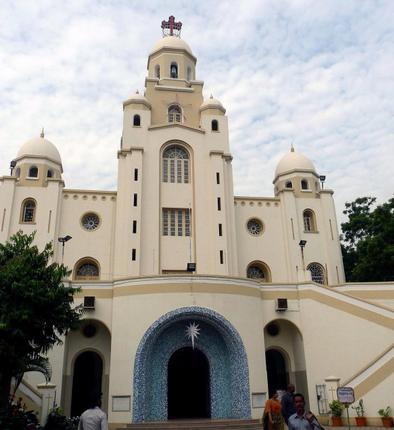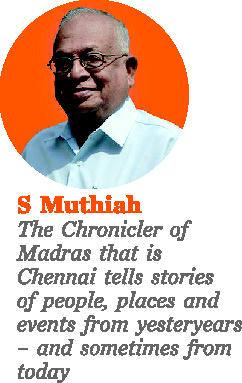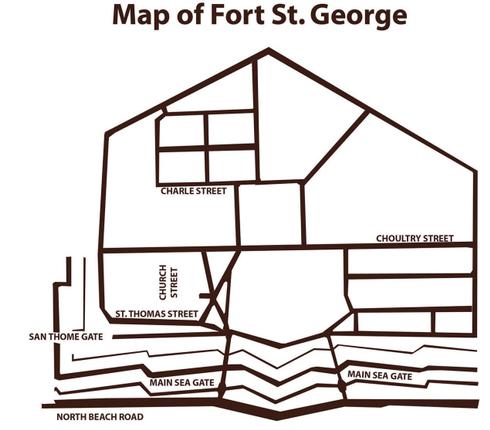
Hard on the heels of catching up with a second esplanade in Madras (Miscellany, April 14) , I’ve been told about another landmark in Madras that I had not heard of before. It is the Shrine of Our Lady of Lourdes in Perambur, a church replicating in form the famous basilica in Lourdes, France. It was designed, I am told, by a “Chevalier Davies, who designed the Catholic Centre in George Town”.
While the plans for building the Shrine date to the 1940s, the Perambur Church’s history goes back a long way before that. It was in 1879 that Fr. H.E. Hennessey from Vepery built a chapel in Perambur near where the Presentation Convent was later established. The next year he dedicated the chapel to ‘Our Lady of Lourdes’. It was to be 1935 when the sixth parish priest, Fr. Michael Murray, began to think of developing the chapel into something like the basilica at Lourdes. He launched a collection drive whose activities and fundraising visits — including collecting the cost of a brick or that of a bag of cement — got a tremendous response that continued through the early 1940s. That’s when the Archbishop of Madras, the Most Rev. Dr. Louis Mathias, invited ‘Chevalier Davies’ to design the shrine to resemble the one in France.
It was to be January 1951, however, before the Archbishop of Madras, Dr. Mathias, laid the foundation stone and February 22, 1953 when he consecrated the lower church of the Shrine. In March 1958, the foundation stone was laid for the upper church and, after another fundraising drive, the work was completed in 1960 and Archbishop Mathias, who had seen the work from conception to completion, was there to consecrate the upper church on February 11, 1960. Today, services are held in Tamil in one church and in English in the other. But in the early years, the congregation was mainly Anglo-Indian, drawn from two institutions which helped the chapel — and Perambur — to grow: The B&C Mills, which were established between 1877 and 1882, and the Railway Workshops established in 1895.
Apart from ‘discovering’ a replica of the Shrine in Lourdes in Madras, I was struck by the ‘Chevalier Davies’ connection. Was he the J.R. Davis of the then leading firm of Madras architects, Prynne, Abbott and Davis (note: no ‘e’)? If he was, he had a great record in Madras, being responsible for, among other buildings, the second Madras Club, in Branson Bagh (in front of which the late, lamented Sapphire Theatre multiplex came up after the Club moved to Adyar), and the Centenary Building of the University of Madras.
******
Questions to celebrate 50
The Association of Geography Teachers of India recently celebrated its Golden Jubilee year. The rather sparse attendance in the hall and the even sparser attendance of those who taught Geography — to judge by the hands raised to a specific question on this — demonstrated the sad state of the subject in our schools and universities. I have no doubt that the situation would have been no different if this had been a gathering of History teachers.
These few teachers, however, continue valiantly trying to keep geographical knowledge in the public eye. Led by Sushila Raghavan and Indu Narayanan they celebrated the occasion with a colourful book titled Geography — Here? There? Everywhere? that everyone interested in the nations of the world and every quizmaster and quizzer should posses.
For forty years, the Association has been conducting a Geography Talent Test for students of Classes VII to X. The questions of the last 15 years have been compiled in this commemoration volume.
Skimming through the book and looking for questions on Madras I found these (rephrased by me) accompanied by suitable maps:
– Plan a heritage tour of George Town marking the following sites and a route to take them all in: Armenian Church, General Post Office, YMCA, High Court-Law College campus, Burma Bazaar, Rajah Annamalai Hall, and Dare House.
– Ram wants to go to Fort St. George from the Tamil Nadu Tourism Office through Anna Salai. What are the two main statues he will pass by?
– In which direction will you travel if you go from Triplicane to Chintadripet?
– Where are these two industrial areas in Madras: Manali and Sembiam?
– Locate the Town Hall, King’s Barracks and the Grand Arsenal in the rough sketch map (alongside) of Fort St. George.
Receiving the first copy of the book was one of the founders of the Association, Visharda Hoon, who during a lifetime of principalships never once forgot that she was a Geography teacher first and last.
*****
When the postman knocked…
* Referring to Sudharma and its owner Sir P.S. Sivaswami Iyer (PSS) whom I had mentioned in (Miscellany, April 7), Viswanathan Venkataraman who grew up as a neighbour writes from the U.S. to say the grand property was sold to Krishnaswami Naidu, son-in-law of G. Raghavel Naidu, a leading timber merchant, and it was from them that Anatharamakrishnan of the Amalgamations group acquired the property. In the Naidu period, when a large joint family occupied the house, the children of the colony had free access to the gardens and tennis courts of Sudharma. But all that was out of bounds to them in Sir P S S’s time. He was a widower in his 90s at the time referred to by Venkataraman and would stroll around his garden every day accompanied by his Man Friday, Gopala Iyer, the only other occupant of the mansion. After he sold Sudharma, Sir PSS moved into a smaller house on the road opposite, then Sullivan’s Garden Road, located behind what was till recently the main Nilgiris store in Madras but which is now Waitrose London. Sir PSS passed away there.
* Recent references to philanthropist Chinnaswamy Rajam in the Press, after the release of a book about the founder of the Madras Institute of Technology, reminded him of another Rajam, writes A. Raman from New South Wales, Ramakrishna Venkata Rajam (RVR). Their paths might well have crossed, he adds. R.V. Rajam, Raman recalls, was a student of Charles Donovan (of leishmaniasis fame) at Madras Medical College and later made the Venereology Clinic at MMC a world-class institute. R.V. Rajam, who passed away just a few months short of his 100th birthday, was the first Indian Dean of Madras Medical College. RVR was also a successful general medicine practitioner whose protégé was K.S. Sanjivi who founded the Voluntary Health Services Hospital. Raman describes RVR, Sanjivi and B. Ramamurthi, the leading neurosurgeon of the day, as a “closed intellectual circle”.
* With the hotel industry in the doldrums — I can think of no other explanation for what is happening — well-known hotels are being — or are scheduled to be – pulled down. They include Dasaprakash, a legendary name, Breeze, a favourite of Sri Lankans for its authentic Sri Lankan cuisine, Aruna (which is mired in a legal dispute) and the Marriott even before it opened. Will others follow, wonders J. Francis. I wouldn’t be surprised at all, unless The New York Times’ listing of Madras as one of the Top 50 destinations of 2014 materialises into footfalls worthy of such a ranking. Another reader wants to know whether any of these hotels would come under the purview of the Heritage Conservation Committee. I don’t think any of them would, except perhaps Dasaprakash for its splendid art deco architecture. But in its case a listing would be too late — it’s already gone, thus setting the trend.
source: http://www.thehindu.com / The Hindu / Home> Features> MetroPlus> Society> Madras Miscellany / by S. Muthiah / Chennai – April 20th, 2014

